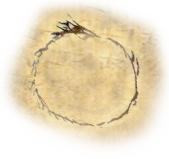Agility Roll
Play Vocabulary
On the topic of the Agility Roll (see also Agility).
The specific agility of a creature or mechanism is derived in a number of ways, depending on the style of game, and in particular, on the usage of dice as it pertains to a characters' vital statistics
In the simplest game, a single base dice is used for all dice rolls (a d6, or six sided dice, for example), this dice adding the random element. The result of this dice roll is offset by (usually fixed) bonuses or penalties as they might apply to the situation. Some bonuses derive from the natural abilities of the character, and other boons or banes come from other sources.
The basic game can be played with dice sizes other than the standard six-sided dice. You might prefer a game where the base dice roll is a d8, d10, d12 or d20. Perhaps you will roll two d6's. Obviously in such games, difficulty ratings for challenges that don't involve opposed rolls will need adjusting.
In general, the character's Sinew vital attribute is the main measure of it's agility or dexterity. For such a character (in the basic game using a single d6 dice), any essay it might make that revolves around nimble movement is as so:
Agility = Character.Sinew (as Sinew) Agility roll: [d6 + Sinew + situational bonuses] (if using d6 base dice)
Certain situations thus call for an ''Agility roll', where a character is required to consult the dice to see if it succeeds. Example is shooting an arrow using a bow:
Aim & Loose Arrow: [d6 + Sinew + 8 ('bow and arrow') ]
ie. d6: six-sided base dice; sinew vital; arrow producing up to 8 damage
ie. the actual damage is offset by the targets evasion attempt and armour.
ie. an hand-thrown arrow will deal up to 3 damage.
Generally, any time a character essays a sinew-based action (or reaction), the dice roll is considered to be an 'agility roll'. But this concept of an agility roll is really only important mechanically, if the game is making use of variable-size base dice, where the dexterity vital alone might not be the only relative measure of agility.
Thus, in another type of game, the base dice is of variable type, depending perhaps on the size or overall power level of the character (and might change rapidly over time as the character is injured and recovers, for example), and in this case, an Agility roll often makes use of an inverse dice scale (because small, light creatures are usually more agile than big and heavy ones), and is seen as a sort of special case.
Thus, the entire notion of an 'Agility roll' is really a mnemonic, a reminder of the 'exception to the rule' - that agility/dexterity/sinew-based essays (be they actions or reactions) will use an inverted dice scale (in the game types that use it).
... ( see Size and Scale )
For example, in such a game, an average-sized (man-sized) character might use a d6 base dice for most activities, except for activities where sinew (and thus agility) are the key component. In agility-bound scenarios, a medium sized character would use a d8 dice, instead of the usual d6, and the bigger the character gets physically, the smaller the dice size used for agility rolls (and vise versa).
A huge creature (which would use a d10 base dice for strength-based activities or other situations where the large body size provides an advantage) would use a d4 for agility-based scenarios. A small cat, which would usually use a d4 base dice for it's power roll in most actions, would use a d12 for agility rolls.
In yet another type of game, there may or may not be a fixed base dice at all, and the characters' vital statistics might be dice rolls instead of fixed bonuses or penalties. So, a character of medium strength uses a d6 for muscle-bound essays such as punching, kicking or jumping, while a highly-intelligent wizard uses a d10 for his brains (aka. mind) vital attribute and applies it during spellcasting. By the same token, a fat burglar might use a d4 to represent his sinew statistic, and thus make his agility rolls (such as pickpocketing) using that dice.
See also:
